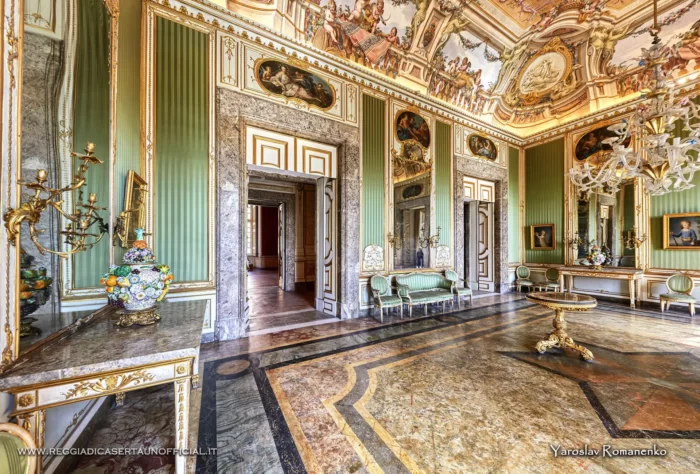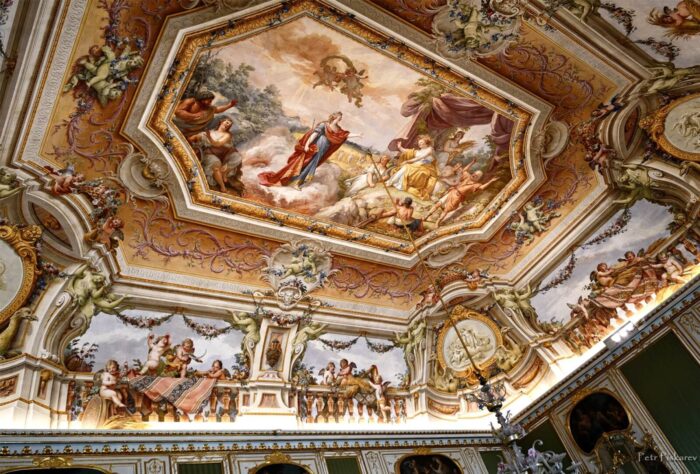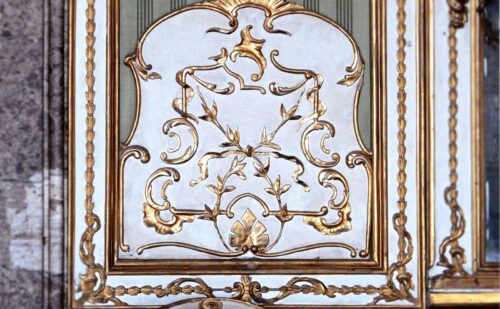The Summer Hall was the King's audience hall
In the Hall of Summer, the former audience hall took place the hand kissing of the King
Description of the Hall of Summer
Known as the Hall of Summer due to the fresco, this room in the Royal Palace of Caserta was used as a hall for hearings and for kissing hands. In the days of kissing the hand, more simplified procedures were followed, when the rulers were not in the Royal Palace of Naples, but in one of the royal sites where, usually, the rigors of etiquette were relaxed. In fact, the strict rules of precedence were no longer followed according to the social prestige possessed but, for example, it was also possible for everyone to stay in the same room. Usually the sovereigns stood each on a cushion, or on a carpet with two thrones and two cushions.
Decorations and furnishings
The fresco
The fresco in the Hall of Summer symbolizes summer and was painted by Fedele Fischetti. It represents the harvest: Proserpina (goddess of spring and wife of Pluto god of the Underworld), meets her mother Ceres (goddess of fertility, protector of crops and living beings).
In the fake balcony there are putti, symbolizing the summer activities, who play at sharpening sickles, untying sheaves and overturning the grain.
In the Summer of Fedele Fischetti, around the composed representation of Proserpina who presents herself to Ceres in an opulent landscape of fodder, groups of cupids burst onto the balustrade busy sharpening scythes, untying sheaves, spilling grain, playing bagpipes.
Decorations and furnishings
Pluto, god of the Underworld, convinces Jupiter, the father of the gods, to allow him to kidnap his daughter Proserpina, had with Ceres. When she the latter, thanks to the sun god, discovered everything about her, in revenge she no longer made the fields sprout, generating famine to kill human beings, to whom the gods cared a lot. Jupiter then understands that the only way to save them is to return Proserpina to her mother. Pluto agrees, but with her own deception: before freeing the girl from her, he makes her eat a pomegranate grain that will forever bind her to the realm of the dead.
When Ceres embraces her daughter again, for her joy the earth flourishes again. Due to Pluto’s deception, in the months in which Proserpina lives with her mother, Ceres causes her nature to be reborn, to then make her bare and arid every time her daughter has to return to the Underworld to her husband Pluto. This is how the seasons were born.
Since this room was used for hearings and hand kisses, therefore for the “concessions” that the rulers made to their subjects, this fresco symbolized their absolute power even over nature.
The fresco
The overdoors in the Hall of Summer were painted by Giovan Battista Rossi with the “Liberal Arts”, while the Rivers of the Kingdom of Naples are personified on the over-mirrors.
The walls are covered in San Leucio silk. The cabinet-making works (boiserie and furnishings) were created by Gennaro Fiore also using lead and tin, then gilded by Bartolomeo di Natale. The walls are equipped with huge one-piece Venetian mirrors, an extremely expensive luxury at the time and a great status symbol.
The chandelier is in Murano glass, the table is in artificial petrified wood, an invention of Girolamo Segato and a unique masterpiece in the world, the porcelains are vases with fruit by Jacob Petit.
External Link







